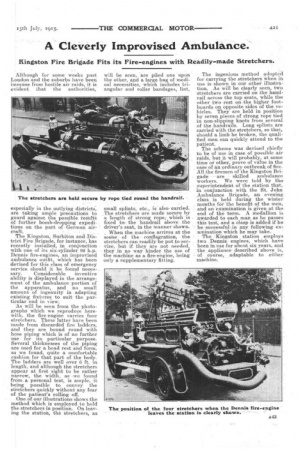A Cleverly Improvised Ambulance.
Page 13

If you've noticed an error in this article please click here to report it so we can fix it.
Kingston Fire Brigade Fits its Fire-engines with Readily-made Stretchers.
Although for some weeks past London and the suburbs have been immune from hostile air raids, it is evident that the -authorities, especially in the outlying districts, are taking ample precautions to guard against the possible results of further bomb-dropping expeditions on the part of • German aircraft.
The Kingston. Surbiton and District Fire Brigade, for instance, has recently installed, in conjunctionwith one of its six-cylinder 92 h.p. Dennis fire-engines, an improvised ambulance outfit, which has been devised for this class of emergency service should it be found necessary. Considerable inventive ability is displayed in the arrangement of the ambulance portion of the apparatus, and no small amount of ingenuity in adapting existing fixtures to suit the particular end in view.
As will be seen from the photographs which we reproduce herewith, the fire-engine carries four stretchers. These latter have been made from discarded fire ladders, and they are bound round with hose piping which is of no further use for its particular purpose. Several thicknesses of the piping are used for a head rest and form, as we found, quite a comfortable cushion for that part of the body. The ladders are well over 43 ft. in length, and although the stretchers appear at first sight to be rather narrow, the width, am we found from-a, personal test, is ample, it being possible to convey the stretchers quickly without any fear of the patient's rolling off.
One of our illustrations shows the method which is employed to hold the stretchers in position. On leaving the station, the Stretchers, as will be seen, are piled one upon the other, and a large bag of medical necessities, which includes triangular and roller bandages, lint, small splints, etc., is alsocarried. The stretchers are made secure by a length of strong rope; which is fixed to the handrail above the driver's seat, in the inanner shown.
When the machine arrives at the scene of the• conflagration, the stretchers can readily be put to-service, but if they are not needed, they in no way hinder the use of the machine as afire-engine, being only a supplementary fitting. The ingenious method adopted for carrying the stretcher i When in use is shown in our other illustration. As will be clearly seen, two stretchers are carried on the handrail across the top seats, while the other two rest an the higher footboards on opposite sides of the vehicles. They are held in position by seven pieces of strong rope tied in non-slipping knots from several of the handrails. Long splints are carried with the stretchers, so that, should a limb be broken, the qualified men can quickly attend to the patient.
The scheme was devised chiefly to be of use in case of possible air raids, but it will probably, at some time or other, prove of value in the case of an ordinary outbreak of fire. All the firemen of the Kingston Bri
gade • are skilled ambulance workers. We were told by the superintendent of the station that, in conjunction with the St. John Ambulance Brigade, an evening. .cfasS is held during the winter months for the benefit of the men, and an examination is given at the end of the term. A medallion is -awarded to each man as he passes this test, and a clasp is added if he be successful, in any following examination which he may take.
The Kingston station employs two Dennis engines, which have been in use for about six years, and the appliance described above is, of course, adaptable to either machine.




















